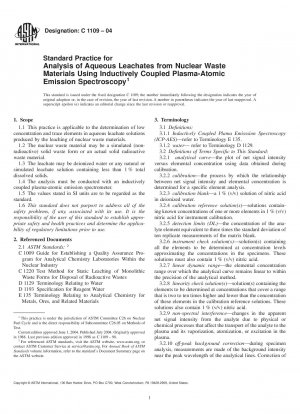ASTM C1109-04
Standard Practice for Analysis of Aqueous Leachates from Nuclear Waste Materials Using Inductively Coupled Plasma-Atomic Emission Spectrometry
- Standard No.
- ASTM C1109-04
- Release Date
- 2004
- Published By
- American Society for Testing and Materials (ASTM)
- Status
- Replace By
- ASTM C1109-10
- Latest
- ASTM C1109-23
- Scope
This practice may be used to determine concentrations of elements leached from nuclear waste materials (glasses, ceramics, cements) using an aqueous leachant. If the nuclear waste material is radioactive, a suitably contained and shielded ICP-AES spectrometer system with a filtered exit-gas system must be used, but no other changes in the practice are required. The leachant may be deionized water or any aqueous solution containing less than 1 % total solids.
This practice as written is for the analysis of solutions containing 1 % (v/v) nitric acid. It can be modified to specify the use of the same or another mineral acid at the same or higher concentration. In such cases, the only change needed in this practice is to substitute the preferred acid and concentration value whenever 1 % nitric acid appears here. It is important that the acid type and content of the reference and check solutions closely match the leachate solutions to be analyzed.
This practice can be used to analyze leachates from static leach testing of waste forms using C 1220
. 1.1 This practice is applicable to the determination of low concentration and trace elements in aqueous leachate solutions produced by the leaching of nuclear waste materials.
1.2 The nuclear waste material may be a simulated (non-radioactive) solid waste form or an actual solid radioactive waste material.
1.3 The leachate may be deionized water or any natural or simulated leachate solution containing less than 1 % total dissolved solids.
1.4 The analysis must be conducted with an inductively coupled plasma-atomic emission spectrometer.
1.5 The values stated in SI units are to be regarded as the standard.
1.6 This standard does not purport to address all of the safety problems, if any, associated with its use. It is the responsibility of the user of this standard to establish appropriate safety and health practices and determine the applicability of regulatory limitations prior to use.
ASTM C1109-04 Referenced Document
- ASTM C1009 Standard Guide for Establishing a Quality Assurance Program for Analytical Chemistry Laboratories Within the Nuclear Industry
- ASTM C1220 Standard Test Method for Static Leaching of Monolithic Waste Forms for Disposal of Radioactive Waste
- ASTM D1129 Standard Terminology Relating to Water
- ASTM D1193 Standard Specification for Reagent Water
- ASTM E135 Standard Terminology Relating to Analytical Chemistry for Metals, Ores, and Related Materials
ASTM C1109-04 history
- 2024 ASTM C1109-23 Standard Practice for Analysis of Aqueous Leachates from Nuclear Waste Materials Using Inductively Coupled Plasma-Atomic Emission Spectroscopy
- 2010 ASTM C1109-10(2015) Standard Practice for Analysis of Aqueous Leachates from Nuclear Waste Materials Using Inductively Coupled Plasma-Atomic Emission Spectroscopy
- 2010 ASTM C1109-10 Standard Practice for Analysis of Aqueous Leachates from Nuclear Waste Materials Using Inductively Coupled Plasma-Atomic Emission Spectrometry
- 2004 ASTM C1109-04 Standard Practice for Analysis of Aqueous Leachates from Nuclear Waste Materials Using Inductively Coupled Plasma-Atomic Emission Spectrometry
- 1998 ASTM C1109-98 Standard Test Method for Analysis of Aqueous Leachates from Nuclear Waste Materials Using Inductively Coupled Plasma-Atomic Emission Spectrometry
